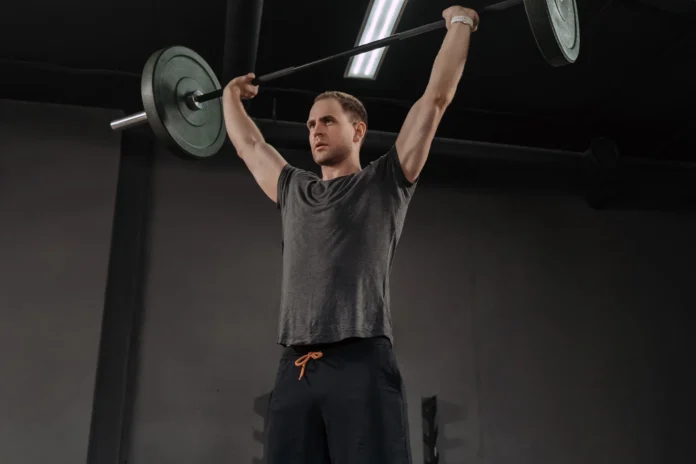There’s something primal about picking up a heavy object, hoisting it up in the air, and lowering it back down to the ground. The military press sparks that feeling. This effective exercise is a feat of strength that’s popular in the powerlifting and bodybuilding world. Because you’re hoisting the weight up overhead, it’s crucial you have proper form to lower your risk of injury, including shoulder injury. Here’s how to perform this movement with proper form to get the benefits.
CONTENTS
- What is the military press?
- What muscles does the military press target?
- What are the benefits?
- How to do the military press
- The most common military press injuries
What is the military press?

The military press is a classic compound weight training exercise that works various muscles, including your deltoids and triceps. You press a barbell over your head straight up in the air before bringing it back down again. You can add this movement to your shoulder training and upper body training days. The military press is similar to the overhead press, but there are slight differences. For example, you need a wider stance to perform the overhead press.
Recommended Videos
The Manual – 2021 Grooming Awards – Best Hair Products
What muscles does the military press target?

The military press primarily focuses on your shoulders with a secondary focus on your chest, core, and back. The military press works your:
- Deltoid shoulder muscles (including anterior and medial delts)
- Pectoral muscles in your chest
- Triceps muscles in the back of your upper arms
- Trapezius muscles in your upper back
What are the benefits?

Because it’s a compound exercise, the military press hits multiple muscle groups in your shoulders, upper back, and core. This exercise also prompts you to work on your range of motion and balance, especially as you’re holding the weight up overhead for a moment.
The military press is one of the most popular go-to exercises to bulk up your shoulders, back, triceps, and core. If you’re looking to strengthen your shoulders and upper back and increase muscle mass, the military press is an excellent choice. You’ll probably see this movement in weightlifting competitions going back throughout the decades and around the globe.
It also turns out that exercises like the military press can boost your testosterone, which brings plenty of benefits. Testosterone is a reproductive hormone that boosts muscle growth and strength, cognitive functioning, and more. An interesting study showed that men who took part in resistance or strength training three days a week for four weeks had an increase in testosterone levels following their workout and over time. Another study revealed that one 30-minute weightlifting session heightened testosterone levels by 21.6% in men and 16.7% in women.
How to do the military press

Here’s how to perform the military press:
- Stand with your feet about shoulders-distance apart.
- Grip the barbell with your hands a little wider than shoulder-width apart and your palms facing down.
- Squeeze your shoulder blades, glutes, and abs. Your knees should be slightly bent.
- Lift the weight up to your shoulders and make sure your forearms are straight and perpendicular to the ground.
- Engage your core and push the barbell up vertically over your head, straightening your arms.
- Hold the position for a moment.
- Carefully lower the weight back down to your shoulders.
- Repeat for your desired number of repetitions.
The most common military press injuries

Proper form is important to lower your risk of injuries. The most prevalent military press injuries and issues are:
- Shoulder strains
- Rotator cuff injuries or dislocation
- Muscle tears
- Muscular imbalances
- Structural deformities
- Impedance of shoulder mobility
- Joint pain
Tips for proper form

Here are some top tips for proper form:
- Try not to arch your back to avoid putting strain on your lower back.
- Try to make sure your knees are slightly bent.
- Squeeze your shoulder blades together.
- Try rotating your elbows forward a few degrees to keep you in the scapular plane.
- Stop the exercise immediately if you notice any pain or discomfort.
- Start with a good warm-up before performing a military press.
- Resting for one or two days before training the same muscle groups gives your body plenty of time to recover.
- Start with lighter weights until you’ve mastered your form.
One of the most common mistakes is putting too much weight on the bar. After mastering your form, you can move up to heavier weights. You should also ensure you can properly perform three sets of 10 to 12 reps before considering increasing the weight.
There are other variations of the military press, including the seated military press and the dumbbell or kettlebell military press. You might need to experiment with different variations to find out what feels best for you.



